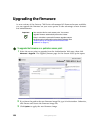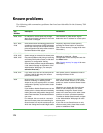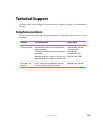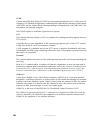176
www.gateway.com
802
IEEE 802 (IEEE Std. 802-2001) is a family of standards for peer-to-peer communication over
a LAN. These technologies use a shared-medium, with information broadcast for all stations
to receive. The basic communications capabilities provided are packet-based. The basic unit
of transmission is a sequence of data octets (8-bits), which can be of any length within a
range that is dependent on the type of LAN.
Included in the 802 family of IEEE standards are definitions of bridging, management, and
security protocols.
802.1x
IEEE 802.1x (IEEE Std. 802.1x-2001) is a standard for passing EAP packets over an 802.11
wireless network using a protocol called EAP Encapsulation Over LANs (EAPOL). It
establishes a framework that supports multiple authentication methods.
IEEE 802.1x authenticates users not machines.
802.2
IEEE 802.2 (IEEE Std. 802.2.1998) defines the LLC layer for the 802 family of standards.
802.3
IEEE 802.3 (IEEE Std. 802.3-2002) defines the MAC layer for networks that use CSMA/CA.
Ethernet is an example of such a network.
802.11
IEEE 802.11 (IEEE Std. 802.11-1999) is a medium access control (MAC) and physical layer
(PHY) specification for wireless connectivity for fixed, portable, and moving stations within
a local area. It uses direct sequence spread spectrum (DSSS) in the 2.4 GHz ISM band and
supports raw data rates of 1 and 2 Mbps. It was formally adopted in 1997 but has been
mostly superseded by 802.11b.
IEEE 802.11 is also used generically to refer to the family of IEEE standards for wireless
local area networks.
802.11a
IEEE 802.11a (IEEE Std. 802.11a-1999) is a PHY standard that specifies operating in the 5
GHz U-NII band using orthogonal frequency division multiplexing (OFDM). It supports
data rates ranging from 6 to 54 Mbps.
802.11a Turbo
IEEE 802.11a Turbo is a proprietary variant of the 802.11a standard from Atheros
Communications. It supports accelerated data rates ranging from 6 to 108Mbps.


















